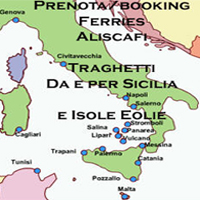An ancient history
From the book “The Aeolian islands” published by the Tourist office – Lipari

The history of the Aeolian islands is basically identical to that of the island of Lipari. The first human settlers came there from Sicily in the Middle Neolithic period (from the fourth millenim BC), in small rudimentary boats. They were farmers ans stockbreeders and also made and decorated pottery and were skin flint cutters: they had found deposits of Obsidian on the island, which was then the most precious mineral.
Black and shiny, obsidian is a very hard , vitreous volcanic rock that is not produced by all volcanoes. It was due to these deposits that the archipelago underwent an extraordinary development in Neolithic times, leading to the growth of villages and the intensification of sea trading, for obsidian was used for making much-needed tools, knives, arrow heads, and blades that were less resistant than those made of flint but much harder. Large quantities of obsidian have been found in the Neolithic villages of Sicily and the Italian peninsula and even on the coasts of southern France and Dalmatia.
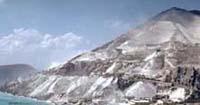 The oldest settlements have been found on the plateau areas of Castellaro Vecchio, while the early centuries of the first millenium BC saw the growth of the first settlement on the Rocca di Castello. Druring the period in which the obsidian trade was in its height and economic wellbeing led to population growth, the settlement expanded onto the Diana plateau, at the foot of Rocca di Castello.
The oldest settlements have been found on the plateau areas of Castellaro Vecchio, while the early centuries of the first millenium BC saw the growth of the first settlement on the Rocca di Castello. Druring the period in which the obsidian trade was in its height and economic wellbeing led to population growth, the settlement expanded onto the Diana plateau, at the foot of Rocca di Castello.
Pumice, a porous variety of obsidian, is also produced by volcanoes and has the same composition ; it is of a greyish white colour and is so light that it floats on water. It was used in prehistoric times as an abrasive stone for finishing tools. Today it is used as an industrial abrasive, in concrete and for soundproofing. The large pumice quarries that have pitted and whitened the slopes of Monte Pilato have provided work for generations of local inhabitants, although quarrying has shown a sharp decline in recent years.
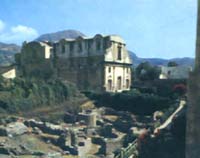 At the end of the third millenium BC, in the early Bronze Age, new settlers came to Lipari and the Aeolian Islands, thus injecting new lifeblood into the economic and cultural life of the area. This reawakening was due to the establishment of regular contacts with the principalities of Mycenaean Greece, whose navigators boldly explored the western seas in search of the raw materials needed to maintain their power and ensure their survival. During those times the islands were visited by Myceanean peoples of Aeolian origins who had already settled in Metapontus and used the islands as outposts for controlling trading routes through the strait of Messina. The islands have retained the name deriving from these Aeolian travellers. The myth of king Aeolus, lord of the winds, that is mentioned in Homer’s Odyssey also derives form Aeolian culture.
At the end of the third millenium BC, in the early Bronze Age, new settlers came to Lipari and the Aeolian Islands, thus injecting new lifeblood into the economic and cultural life of the area. This reawakening was due to the establishment of regular contacts with the principalities of Mycenaean Greece, whose navigators boldly explored the western seas in search of the raw materials needed to maintain their power and ensure their survival. During those times the islands were visited by Myceanean peoples of Aeolian origins who had already settled in Metapontus and used the islands as outposts for controlling trading routes through the strait of Messina. The islands have retained the name deriving from these Aeolian travellers. The myth of king Aeolus, lord of the winds, that is mentioned in Homer’s Odyssey also derives form Aeolian culture.
During the thirteenth century BC, the islands were settled by Ausinian peoples from the coasts of Campania, who brought with them the myth of King Liparus, which is were the town’s name derives from. The islands underwent a process of depopulation during the tenth centuries BC – possibly due to rivalry between different races for supremacy in the lower Tyrrhenian Sea – and they remained all but deserted for several countries.
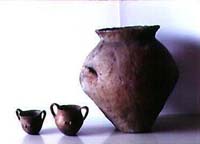 During the fiftieth Olympiad (580-576 BC), Lipari was colonised by some Greeks of Doric origin from Cnidus and Rhodes, who were led by a Heraldic named Pentathlos and had earlier made an unsuccessful attempt to found a colony at modern-day Marsala. The new colonists were the first and foremost faced with the need to fight off Etruscan incursions. They therefore created a powerful fleet, which led them to many victories and ensured them maritimes supremacy. They used captured booty to erect some splendid votary monuments in the Temple of Apollo at Delphi – over forty bronze statues whose bases can still be seen. The ships of Lipari dominated the lower Tyrrhenian area and in 393 BC they intercepted a Roman ship on its way to Delphi with a large gold urn constituting a tenth part of the booty taken following the sack of Veii.
During the fiftieth Olympiad (580-576 BC), Lipari was colonised by some Greeks of Doric origin from Cnidus and Rhodes, who were led by a Heraldic named Pentathlos and had earlier made an unsuccessful attempt to found a colony at modern-day Marsala. The new colonists were the first and foremost faced with the need to fight off Etruscan incursions. They therefore created a powerful fleet, which led them to many victories and ensured them maritimes supremacy. They used captured booty to erect some splendid votary monuments in the Temple of Apollo at Delphi – over forty bronze statues whose bases can still be seen. The ships of Lipari dominated the lower Tyrrhenian area and in 393 BC they intercepted a Roman ship on its way to Delphi with a large gold urn constituting a tenth part of the booty taken following the sack of Veii.
But their chief magistrate, Timasiteus, made their return it because it was a sacred offering to Apollo, the god worshipped by the people of Lipari. In 427 BC, during the first Atenian expedition to Sicily, the people of Lipari entered into an alliance with the Syracusans, perhaps of their common Doric origins. Thucydides reports that they were attacked by the fleets of Athens and Regium, though with serious consequence.
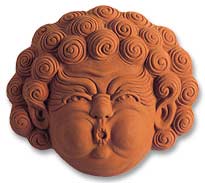 In 262 BC, the Roman consul Cn. Cornelius Scipio, mistakenly believed that Lipari could easily be taken and was captured with all of his men by Hannibal. In 258 Aulius Atilius Calatinus besieged Lipari. In 257 the waters around the Aeolian Islands were the site of a fierce battle between the fleets of Carthage and Rome. Lipari was conquered by the Romans in 252 BC. Razed to the ground with “inhuman cruelty” it lost independence and economic prosperity. This was the beginning of a period of great decline.
In 262 BC, the Roman consul Cn. Cornelius Scipio, mistakenly believed that Lipari could easily be taken and was captured with all of his men by Hannibal. In 258 Aulius Atilius Calatinus besieged Lipari. In 257 the waters around the Aeolian Islands were the site of a fierce battle between the fleets of Carthage and Rome. Lipari was conquered by the Romans in 252 BC. Razed to the ground with “inhuman cruelty” it lost independence and economic prosperity. This was the beginning of a period of great decline.
In the carthaginian expedition of 408-406 BC, Lipari was again allied with Syracuse: However, it was attacked by the Carthaginian general Himilcon, who took control of the town and forced its inhabitants to pay a randsom of 30 talents. Once the Carthaginian had left, Lipari again became completely independent.
During the time of Dionysius the Elder, Lipari remained an ally of Syracuse and later of Tindari. In 304 BC, the island was attacked by Agathocles, who imposed a tribute of 50 talents, which he then lost while sailing to Sicily in a storm that was attributed to the anger of Aeolus.
Lipari later fell under the dominion of Carthage and was still in Carthaginian hands at the outbreak of the first Punic War. The archipelago became a solid Carthaginian stronghold because of its excellent ports and important strategic position.
 The island still continued to make great profits from alum, which was probably already being extracted in the Bronze Age on the island of Vulcano and for which Lipari held the monopoly in ancient times. The excellent thermal springs in Vulcano and Lipari were very popular and also very famous in Imperial Rome. Cicero wrote of Lipari and of the injustices it suffered at the hands of Verres.
The island still continued to make great profits from alum, which was probably already being extracted in the Bronze Age on the island of Vulcano and for which Lipari held the monopoly in ancient times. The excellent thermal springs in Vulcano and Lipari were very popular and also very famous in Imperial Rome. Cicero wrote of Lipari and of the injustices it suffered at the hands of Verres.
The Aeolian Islands were of great strategic importance during the civil war between Octavian and Sextus Pompey. Lipari, was fortified by Sextus Pompey and conquered by Octivian’s admiral, Agrippa, in 36 BC. He made the island of Vulcano his naval base during the operations preceding the sea battle at Milazzo and for his subsequent landing in Sicily. On this occasion, Lipari again suffered devastation and disaster. It would appear that the island subsequently enjoyed the status of municipium and it was defined by Pliny as oppidum civium romanorum.
There is no mention of Lipari during the entire period of Imperial Rome (first-fourth century AD). All we know is that having his father-in-law Plautianus killed, the Emperor Caracalla sent his wife, Plautilla, and his brother-in-law, Plautius, into exile there for the rest of their lives. During the Christian period, (perhaps from the fourth century AD), Lipari was an episcopal see and the relics of Saint Bartholomew were venerated in its cathedral at least as early as the sixth century. According to traditions dating back to Byzantine writers, the relics were brought there from Armenia by miracle
In the late Middle Ages, Lipari was the destination of pilgrims from near and far. This was the period in which a great variety of legends grew up around the Aeolian Islands, particularly Lipari and Vulcano. The crater of Vulcano was said to be the mouth of hell, in which the souls of the wicked were burned. There is also a well-known legend narrated by Saint Gregory the Great : apparently a local hermit saw the soul of Theodoric, the Ostrogoth King thrown into the crater on the day of his death by Pope John and the patrician Simmac, whom had had murdered.
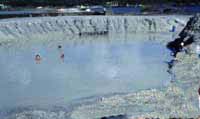 Other legends concerned Bishop Agathon and Saint Calogero, the hermit who rid the island of devils and caused the water to flow from the spring that bears his name. During the early Middle Ages, the volcanoes on the island of Lipari suddenly became active after being dormant for decades. It was then that new craters opened on Monte Pelato, which threw out enormous masses of pumice, and on Pirrera, the volcano closest to the town, from which a flow of obsidian erupted.
Other legends concerned Bishop Agathon and Saint Calogero, the hermit who rid the island of devils and caused the water to flow from the spring that bears his name. During the early Middle Ages, the volcanoes on the island of Lipari suddenly became active after being dormant for decades. It was then that new craters opened on Monte Pelato, which threw out enormous masses of pumice, and on Pirrera, the volcano closest to the town, from which a flow of obsidian erupted.
In 839, Lipari was attacked and destroyed by Muslim marauders, who massacred many inhabitants, took others as slaves and violated the relics of Saint Bartholomew. The relics were then piously gathered together by some old friars who had escaped the massacre and transported to Salerno in the following year and subsequently to Beneventum. Lipari remained almost completely deserted for several centuries until the Normans reconquered Sicily and sent Abbot Ambrogio and a small group of Benedictines to settle on the island in 1083. A small community began to form again around the monastery, the remains of which can still be seen at the side of the cathedral. In 1131, the episcopal see was reconstituted on Lipari and united with the see at patti. In 1340, Lipari fell into the hands of King Roberto I of Naples. In 1540, the town was sacked by the ferocious pirate Ariadeno Barbarossa, who took the unfortunate inhabitants into captivity. Lipari was later rebuilt and repopulated under Carlo V and after that its fortunes followed those of Sicily and the Kingdom of Naples.
Per ulteriori informazioni:






